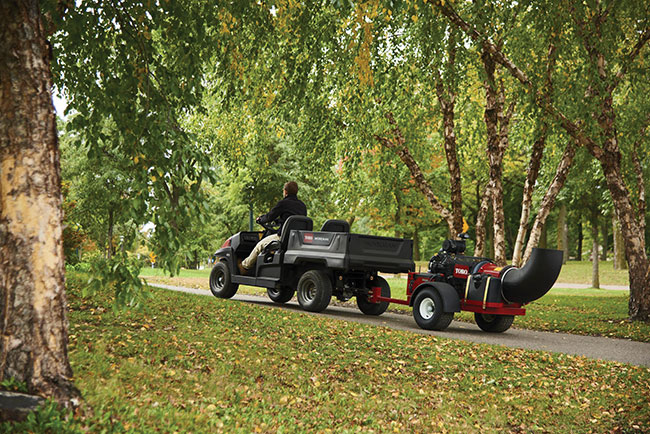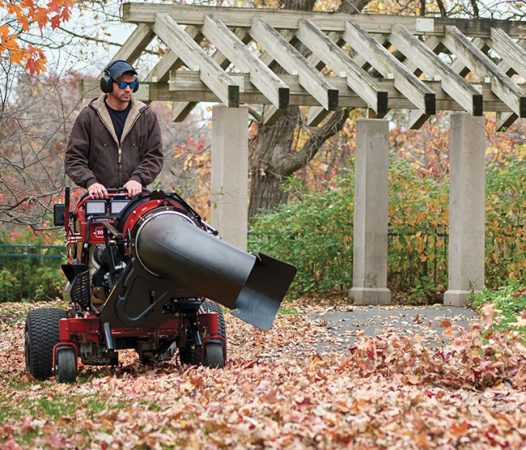
Features
Fall/Winter Preparations
Mowers
Municipal
Sports turf
Make sports turf clean-up a priority this fall season
Give your turf a healthier head start in the spring
October 18, 2021 By Boyd Montgomery and Matt Anderson
 Turbine blowers will clear clippings and leaves from turf, allowing it to breathe over the winter.
Photo Courtesy of The Toro Company
Turbine blowers will clear clippings and leaves from turf, allowing it to breathe over the winter.
Photo Courtesy of The Toro Company Prepare the right way this fall to be rewarded with a more successful spring. With adequate cleanup, attention to detail, and proper equipment maintenance, your turf will have a healthier life come next year. The standard practices of debris management, fertilization, overseeding, and auditing irrigation systems will help the turf achieve the health and vitality it needs to thrive throughout the winter.
Manage debris
Before you fertilize, clear the turf of leaves and debris. If your fields are surrounded by mature trees, this can be a monumental task, but it’s necessary for turf health. Allowing the grass to breathe over the winter allows it to receive the proper nutrients, avoiding serious disease and discolouration.
There are multiple ways to make debris management quicker and easier. To start, turf managers can consider adding a debris blower and a sweeper to their fleet. A debris blower is an extremely versatile tool for fields that uses a turbine style blower to clear grass clippings and leaves. They have enough force to send wet, heavy leaves flying in the direction you want them to go. It even uses a wireless remote, giving the operator complete control without needing to leave the tractor.
A sweeper/vacuum can also be a timesaving piece of equipment. If your fields tend to collect a lot of leaves and debris, a sweeper machine will pick it up and clear it out. Sweepers combine a powerful vacuum, precision pickup capabilities, and a large hopper to reduce trips back and forth for dumping.
Fertilize
Fertilizing in the fall is an easy way to restock your field turf’s reservoir of vital nutrients after a long, hot summer. The extra boost will both help turf survive the upcoming winter and give it a head start on growth next year. Make sure to use a fast-release style fertilizer that allows the turf to take up nutrients quickly before going dormant for the winter.
Overseed
Overseeding is a technique used to revive the thickness of plant growth in select areas – and fall is the ideal time to overseed. To get the most out of these efforts, turf managers should prepare and care for the turf beforehand, giving the new seed the best opportunity to thrive. Here’s how:
Mow the grass. Mow the turf slightly shorter than usual and bag clippings to ensure the seeds have a clear path to reach the soil and receive enough sunlight to grow. Continue mowing at this length on a regular basis throughout the fall season. Avoid cutting more than one-third of the grass at a time, since fall season grass is more susceptible to injury.
Remove thatch buildup. Raking up thatch is recommended for the same reasons as mowing shorter and bagging the clippings are – to allow the seeds room to reach the soil. Use a rake to dethatch manually, or a power rake for an extra boost.
Aerate the soil. Aerating in the fall is not only an essential step, but one of the most important actions turf managers can do to maintain their fields’ health and playability. Aerating loosens the soil and gives the seeds the best chance to take root.
Address soil nutrition. The most important factor in seeding success is seed-to-soil contact, but a close second is soil nutrition. Fall is a good time to get the soil tested for nutrient deficiencies to ensure seeding success. Turf managers can reach out to their local extension office for assistance and resources on soil testing.

Photo Courtesy of The Toro Company
Audit irrigation systems
Make it a yearly habit to audit your irrigation systems for leaks, sprinkler head cracks, and unusual puddling. If repairs are needed, the fall season is an excellent opportunity to cross them off the list. Once the irrigation systems are audited and repaired, the systems should be winterized.
Winterizing irrigations systems involves blowing out the pipes to remove any water, turning off the water source, and checking for damage to the electrical components. Skipping this step could lead to pipes freezing, bursting and leaving you with much larger problems. Being proactive in the fall will both protect the integrity of the irrigation system once it is started up again.
Maintain equipment
Spring and summer are tough on equipment, but that’s what makes fall maintenance so crucial. Set your machines up for success in the spring by following preventative maintenance and servicing standards throughout the fall and winter.
Maintenance should include changing fluids, replacing worn hydraulic hoses, replacing mower blades, checking and cleaning air filters, sharpening or replacing reels, and cleaning and rebuilding painter pumps.
Keep a record of service dates and maintenance schedules for your own reference in the future.
Store equipment
How you store equipment is dependent on where it’s being stored – either in a controlled environment or an environment with colder temperatures. If machines are stored in a heated building, no extra precautions are necessary. If equipment is going to be stored in a cold environment, on the other hand, turf managers should use a fuel stabilizer and consider using engine heating blankets to protect the engine.
Boyd Montgomery and Matt Anderson are certified sports field managers with The Toro Company.
This article is part of the Fall & Winter Prep Week Week.
Print this page